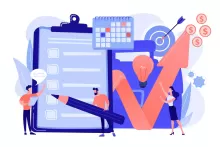Is Your Credit Card Allowing Overdraft? Know the Limit
Many people think that credit cards simply stop working once you reach the limit. But in some cases, your credit card may allow something called an overdraft. Sounds confusing? Don’t worry—this guide will explain what an overdraft on a credit card means, how it works, and what you should watch out for. Imagine this—you’re shopping or paying a bill, and your credit card is already maxed out. But somehow, the transaction still goes through. No error, no decline.
How to Increase Your Credit Card Limit Easily
If you want to spend more with your credit card or manage money better, you might want a higher credit limit. Getting a limit increase is not too hard if you follow the right steps.
This guide explains everything in a simple way so you can understand how to get a higher credit card limit without any confusion.
Co-Branded Credit Cards: What They Are & How They Work
Credit card use is growing quickly in India. As per RBI data, people spent ₹1.89 lakh crore using credit cards in December 2024, which is 11.1% more than in December 2023. Even though spending dropped a little in January 2025, it was still 10.6% higher than the same month last year. This growth is happening because getting a credit card has become easier, and more people are spending on shopping, travel, and daily needs. Young people, in particular, are using credit cards more often to earn rewards and manage their spending.
The Power of Good Credit: 10 Benefits of a High Credit Score
A credit score may seem like just a small number, but it can make a big difference in your financial life. This number can affect everything from the loans you qualify for to the rates you pay and even your job prospects. Having a good credit score can open doors to opportunities that may be harder to access with a lower score.
In this blog, we'll explore the key benefits of having a good credit score and how it can help you financially.
What Happens When You Default on a Credit Card?
A credit card default happens when you stop making the minimum payments on your credit card for a long time, usually for six months or more. While this isn’t something anyone wants, it happens more often than you might think.
In India, a lot of people struggle with credit card debt, and many find it hard to manage. The number of defaults is on the rise, with banks noticing more people falling behind on payments. If you have a credit card, here’s what you should know about defaults and how they can affect your credit:
What happens if you only pay the minimum on your credit card?
When you get your credit card bill every month, it shows the total amount you spent. But it also shows something called the "minimum payment" or "minimum due." This is the smallest amount you need to pay to avoid late fees or getting in trouble with the bank.
Usually, this is about 5% of your total bill, but it can be different depending on the bank.
Credit Card Disputes: What They Are and How to Raise One
Credit cards make transactions easy, secure, and fast. But sometimes, things can go wrong—like unauthorized charges or wrong billing amounts. That’s when you need to know how to raise a credit card dispute. Whether it's a fraud charge or a merchant error, understanding the dispute process helps you protect your money.
Credit Card Secrets: Tips Banks Don’t Want You to Know
Credit cards are useful for handling your expenses, improving your credit score, and getting rewards like cashback or points. They can make payments easier and help you track your spending. But in India, credit card companies don’t always share all the important details clearly. Knowing these hidden facts can help you make better use of your card and avoid common mistakes.
Pros and Cons of a Balance Transfer: What You Need to Know
A balance transfer is a helpful way to deal with high-interest credit card debt. It lets you move what you owe from one or more credit cards to another card that usually has a 0% interest offer for a short time. This means you can pay off your debt without extra interest adding up during that period. It can help you save money and pay off what you owe faster. But there are also some things to watch out for, like transfer fees, higher interest rates after the offer ends, and the need for a good credit score to qualify.
What is a Balance Transfer Credit Card?
A balance transfer credit card lets you move your debt from your old credit cards to a new one. The new card often has a lower interest rate or even no interest for a limited time. This means you can focus on paying off what you owe without extra interest charges. It makes paying off debt easier and helps you save money.
Cash Advance Fee on Credit Cards: What You Need to Know
A cash advance lets you withdraw cash using your credit card, just like taking money from an ATM. It can be helpful when you need urgent cash, but it comes with high costs. In India, using a credit card for cash withdrawals includes extra fees and high-interest rates, making it an expensive option. Knowing these charges in advance can help you manage your money better and avoid unnecessary debt.
Contactless Credit Cards in India: A Comprehensive Guide
Contactless credit cards are becoming increasingly popular in India. With advancements in payment technology, many banks now issue contactless cards that allow quick and secure transactions without inserting the card into a machine. But how do these cards work? Are they safe? Which banks offer them? Let’s explore everything you need to know about contactless credit cards in India.
UPI on Credit Cards: A Quick Guide to Activation and Usage
Payments are changing fast, and one big shift is the introduction of UPI (Unified Payments Interface) on credit cards. UPI, which was first linked to bank accounts and debit cards, can now be used with credit cards. This means you can pay directly from your credit card using your smartphone. This guide will explain how to activate and use UPI on your credit card.
Gen Z Trends 2025: What Marketers Need to Know in India
As Generation Z (born between 1997 and 2012) continues to grow and make its mark on the world, Indian marketers in 2025 need to understand how this generation’s unique preferences are reshaping the consumer landscape. Known for their tech-savviness, social consciousness, and commitment to authenticity, Gen Z is driving key trends in India’s rapidly evolving market. If businesses want to successfully engage this generation, they must stay ahead of the curve and tap into what matters most to them. Here’s what marketers need to know about Gen Z Trends 2025 in India.
The Future of Credit Card Loyalty Programs in a Cashless Society
As the world becomes more digital and cashless, credit card loyalty programs are going through a significant transformation. With over 70% of consumers choosing digital payment methods, it’s clear that the future of spending is shifting away from physical cash. This change is also affecting how we engage with credit cards and their reward systems. Traditional loyalty programs that once focused on points, cashback, or miles are now adapting to keep up with changing technology, consumer behavior, and societal values.
Smart Moves for Gen Z: Surviving the 2025 Stock Market Crash
The 2025 stock market crash has caught investors by surprise across the globe, and for Gen Z in India, this might be the first major financial crisis they have experienced. While the market downturn can be unsettling, there are strategic steps you can take to not only survive but also come out ahead. Whether you're new to investing or already have some experience, this guide will help you navigate the current market chaos with confidence and make smart financial decisions in the Indian context.
10 Fixed Income Sources Every Gen Z Needs for Stability
In today’s unpredictable financial landscape, diversifying income sources is key to ensuring long-term financial stability. For Gen Z, starting early with fixed income sources is a smart move. These types of investments offer predictable returns and lower risks, making them ideal for building wealth and securing financial futures. Here’s a breakdown of 10 fixed income sources that can provide steady income, reduce financial risks, and contribute to long-term stability:
A Gen Z Investor's Strategy to Be a Millionaire by Age 30
Hey Gen Z! If you’re reading this, you probably have big dreams—like becoming a millionaire before hitting your 30s. While that might sound like a lofty goal, the good news is it’s entirely possible with the right mindset, discipline, and strategy. So, let’s break down the best steps to help you reach financial freedom and set yourself up for a prosperous future in India. Here’s how you can turn that dream into reality.
Stock Market - Understanding ETFs and Similar Investment Products
In the dynamic world of stock trading, ETFs have emerged as a popular investment vehicle. An ETF, or Exchange-Traded Fund, is a type of investment fund that is traded on stock exchanges, much like individual stocks. ETFs hold assets such as stocks, commodities, or bonds and generally operate with an arbitrage mechanism designed to keep trading close to its net asset value, though deviations can occasionally occur.
How Gen Z is Earning Through Online Education and Tutoring
Gen Z is making waves in the world of online education and tutoring. With their tech-savvy nature and adaptability, they're capitalizing on the booming demand for digital learning. Here's a detailed look at how they're doing it, and how you can too!




















